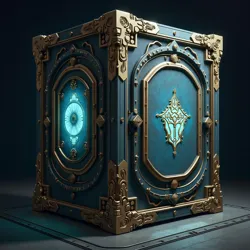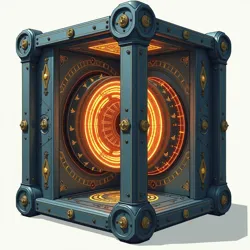Enchanted Containment Units
 A modern Class-VII enchanted containment unit displaying characteristic arcane ward patterns during routine maintenance
A modern Class-VII enchanted containment unit displaying characteristic arcane ward patterns during routine maintenanceEnchanted containment units (ECUs) are specialized magical devices designed to safely store and transport hazardous magical substances, artifacts, and entities. First developed by the Guild of Systematic Thaumaturgy during the early Age of Shadows, these units have become essential tools in magical research, industrial thaumaturgy, and security applications. Modern ECUs incorporate multiple layers of protective enchantments, physical barriers, and temporal stabilization mechanisms to ensure the safe containment of dangerous materials.
Design Principles
The fundamental architecture of enchanted containment units is based on the Principles of Arcane Isolation established by Master Artificer Valyn in the year 847 of the Third Age. These principles dictate the use of nested containment fields, each operating on different magical frequencies to prevent resonant breaches. The primary containment layer typically consists of a physically reinforced chamber enhanced with binding runes and surrounded by multiple layers of protective wards.
Modern ECUs employ what is known as the Triple-Barrier Protocol: an outer shell of mundane but magically reinforced materials, a middle layer of pure enchanted energy, and an inner containment field specifically attuned to the properties of the stored substance or entity. This layered approach has proven particularly effective in containing substances like Voidure Black and other highly reactive magical materials, though even these advanced systems require regular maintenance and monitoring.
Types and Classifications
The International Council of Chromatic Control maintains strict standards for ECU classification based on containment capability and security features. The most common variants include research-grade units used in laboratory settings, industrial-scale containers for bulk material storage, and highly specialized units designed for specific dangerous substances.
Standard classifications range from Class-I (suitable for basic magical reagents) to Class-X (required for reality-altering substances). Each class incorporates progressively more sophisticated containment mechanisms and safety features. Class-VII and above units must include temporal stasis fields and emergency void purge systems as mandatory safety features.
Energy Systems
 Technical diagram showing the layered power distribution system of a Class-VIII containment unit
Technical diagram showing the layered power distribution system of a Class-VIII containment unitThe maintenance of stable containment fields requires substantial and consistent magical energy input. Modern ECUs typically employ multiple redundant power sources, including conventional thaumic generators, emergency crystallized mana reserves, and in high-security installations, direct connections to ley line nodes. The power distribution system must maintain perfect stability, as even momentary fluctuations can compromise containment integrity.
Advanced units incorporate self-sustaining enchantment loops, a revolutionary development that allows the containment fields to partially power themselves through the careful recycling of ambient magical energy. This technology, while expensive to implement, has significantly improved the reliability of long-term storage solutions.
Safety Mechanisms
Every certified ECU includes multiple layers of safety systems designed to prevent containment breaches and protect surrounding areas in case of failure. Standard features include automatic ward reinforcement, breach detection sensors, and emergency shutdown protocols. Higher-class units also incorporate dimensional anchoring to prevent extra-dimensional breaches and thaumic dampening fields to suppress magical reactions.
The most sophisticated containment units feature intelligent response systems capable of adapting their containment parameters in real-time based on the behavior of the contained substance or entity. These systems utilize advanced enchantment matrices developed by the Department of Chromatic Containment to predict and counteract potential breach scenarios before they fully develop.
Maintenance Requirements
The complex nature of enchanted containment units necessitates regular maintenance and inspection. Standard protocols require weekly diagnostic scans of all containment fields, monthly physical inspections of ward integrity, and quarterly complete power system overhauls. Units containing particularly dangerous materials may require daily monitoring and continuous adjustment of containment parameters.
Maintenance procedures must be performed by certified Containment Specialists who have completed extensive training in both practical enchantment work and emergency response protocols. The Guild of Systematic Thaumaturgy maintains strict certification requirements and requires regular recertification to ensure maintenance standards remain current with technological advances.
Applications
While primarily associated with dangerous substance storage, enchanted containment units serve various purposes across multiple fields. Research institutions use specialized ECUs for conducting experiments with unstable magical phenomena, while industrial facilities employ large-scale units for bulk storage of reactive magical materials. The medical sector has adapted ECU technology for the safe handling of biothaumic substances and the containment of magically transmitted diseases.
Military and security applications include portable tactical containment units for field operations and emergency response scenarios. These units sacrifice some containment capability in favor of mobility and rapid deployment features, though they maintain core safety requirements for short-term containment of dangerous materials.
Recent Developments
Current research in containment technology focuses on improving efficiency and reliability while reducing maintenance requirements. The development of self-repairing ward patterns and advanced power management systems has led to significant improvements in containment duration and stability. Experimental work with phase-shifted containment fields shows promise for creating more compact and energy-efficient units.
See Also
- Temporal Stasis Fields
- Void Realm Manifestation
- Thaumic Flux
- Arcane Resonance
- Theory of Chromatic Interconnection
References
- "Standard Protocols for Magical Containment" - Guild of Systematic Thaumaturgy
- "Advanced Containment Engineering" - Department of Chromatic Containment
- "Principles of Enchanted Storage Systems" - Academy of Spectral Studies